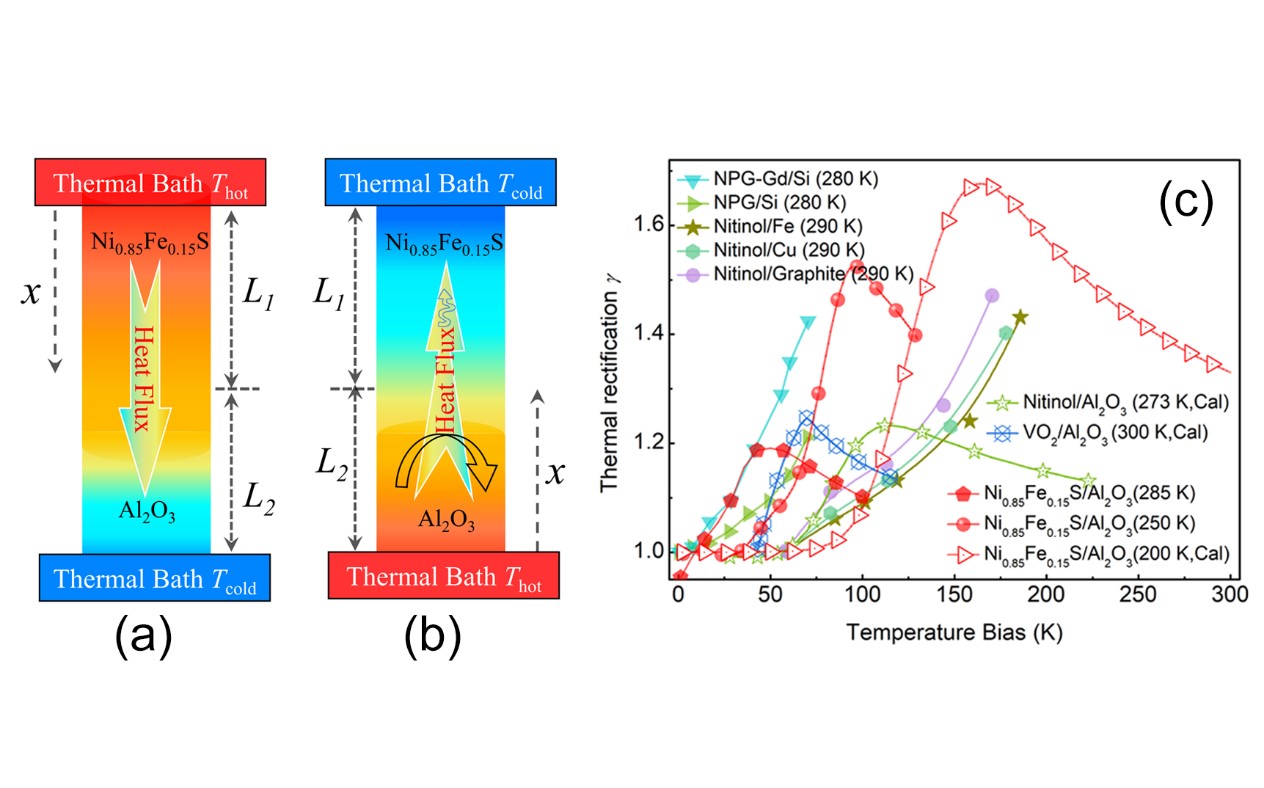
The effective control of heat transfer is of great significance to improve energy efficiency. Thermal diode is one of the key elements for heat flow controlling. Similar to the current rectification effect of electronic diodes, heat flow is easily directed through one direction in a thermal diode, while obstructed in the opposite direction. Sizable heat rectification can be obtained using a junction of two solid materials with opposite trends in thermal conductivity as a function of temperature. This type of thermal diodes is attractive due to their scalability and analogy to electrical diode design.
A team led by Prof. TONG Peng from Institute of Solid State Physics (ISSP), Hefei Institutes of Physical Science (HFIPS) , Chinese Academy of Sciences (CAS) had reported that they've found sulfides Ni1-xFexS, a series of materials that may unlock new ways to better thermal rectification. Recently, the same team announced that they constructed a novel thermal diode with a combined material of Ni0.85Fe0.15S and alumina, which displayed excellent performance over solid-state thermal diodes ever reported. Their up-to-date result was published on Journal Physical Review Applied.
In their previous study, the team discovered the abrupt jump of thermal conductivity in the vicinity of the first-order phase transition (FOPT) in Ni1-xFexS. The change of thermal conductivity reaches as large as 200%, which suggests the sulfides are promising materials for designing solid-state thermal diodes. On this base, the team constructed a thermal diode with Ni0.85Fe0.15S (bonded by 10wt.%Ag) and Al2O3 as two segments. The thermal diode exhibits excellent thermal rectification performance. When the cold end of the thermal diode is set at 250 K, at a temperature bias of 97 K, the maximum thermal rectification coefficient γmax reaches 1.51.
The Ni0.85Fe0.15S/Al2O3 thermal diode shows advantages over other solid-state thermal diodes ever reported. Namely, its γmax is the largest among the reported values, meanwhile the requested temperature bias for driving γmax is at least 100 K less than that of reported thermal diodes having comparable γmax values. The outstanding thermal rectification effect of the current thermal diode may have potential applications in thermal management systems, for example, caloric refrigeration and energy conversion. Moreover, on the base of systematical experimental and theoretical analysis, the team clarified how the thermal rectification factor is affected by the cold terminal temperature, the length ratio of Ni0.85Fe0.15S and Al2O3 segments, and the sharpness of the FOPT of Ni0.85Fe0.15S.
These new results provide guides for designing new solid-state thermal diodes in the future.
This work was supported by the National Natural Science Foundation of China, the Key Research Program of Frontier Sciences and the Users with Excellence Program of Hefei Science Center of the Chinese Academy of Sciences.
Link to the paper: Large Thermal Rectification in a Solid-State Thermal Diode Constructed of Iron-Doped Nickel Sulfide and Alumina

(a) and (b) represent for the schematic geometry of the thermal diode consisting of Ni0.85Fe0.15S and Al2O3 for forward and reverse direction. (c) Thermal rectification factor (γ) as a function of temperature bias (ΔT) along with those reported. (Image by ZHANG Xuekai)
Contact:
ZHAO Weiwei
Hefei Institutes of Physical Science (http://english.hf.cas.cn/)
Email: annyzhao@ipp.ac.cn